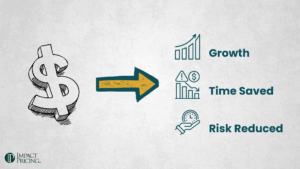We all subscribe to something today. We subscribe to cell phones, TV or video services, music services, news outlets, gym memberships, and that’s before we get to software services like Microsoft Office, a sales CRM, and any of the thousands (literally) of marketing tools you could subscribe to. At last count, Impact Pricing subscribes to over 20 services to help run our website, marketing, and product delivery. If you don’t subscribe to anything, I’d love to know how you live. Call me and tell me.
We may be getting subscription overload, but we love subscriptions. Here’s why.
What do we buy?
We buy the benefit not the product: In the old days, we would buy a product. Even software was a set of physical disks and a manual shrink wrapped in a box. We were buying a thing. We hoped the thing solved a problem for us, but we bought the thing. In the world of subscription though we don’t buy things. We buy benefits. We are much more clear on what we need.
I recently signed up for LastPass, a password management service. While shopping, I wasn’t thinking, “I need to buy a program to manage passwords.” No. I was thinking, “I need to find a way to make it easy for dad and I to share and manage passwords.” I was shopping for the benefit, and I found it.
The benefits
They are simple and logical:
Subscriptions seem to be simple and logical to use. From a user perspective, we can get up and running on a new product and start receiving the desired benefit relatively quickly. It is rare to subscribe to something that has a long learning curve.
It turns out this is by design. When a company wins a new customer, they want that customer to stay. Customers only stay if they get value out of your product. Hence, companies make their products easy for beginners so they get value quickly and don’t want to leave. Customers who don’t use the product will stop paying for the product.
Ability to grow:
We often start with a small amount of the subscribed service, but as we love it more, we know that we can get more. Buyers want to know that as they need more of the benefit, it is available to them. This is especially true for business buyers. As a company grows, they want the product to continue to support to them.
Subscription based companies build this into their products in many ways. Buyers can pay based on some usage metric so as they use more, they pay more. They can upgrade to a more functional version of the product. And they can buy different yet compatible products to add to their current subscription.
Lower risk:
We LOVE that we can subscribe to something for a very low entry price to see if it really provides the benefits we expected. In the old days, we committed the total amount of money up front before we start using the product. We just hoped the product would perform as promised. Now, we buy for a month or two and if it doesn’t deliver on our expectations, we stop paying and are out at a much smaller investment.
Products are better:
Subscription products just seem to work better than the old shrink wrap products. It turns out, they do. The reason is, the subscription company wants us to keep paying them for their product. If it has too many bugs, we will stop paying for it. If the product is stagnant and we find a better solution to our problems, we will switch. In the old days, companies didn’t really care if we were happy because they already had our money. Subscription companies care a lot if we are happy. That means they constantly work to make their products better.
When we subscribe to a new offer, the product is probably better than if we had bought a solution outright. Yet, over the life of the product it will get even better. As we pay our monthly subscription, the vendor adds more features and capabilities. We often get more than what we originally agreed to pay for. 🙂
For those of us who buy subscriptions for our businesses, there are even more advantages.
… more Advantages
Easier to calculate ROI: We subscribed to solve a problem which has some cost to us. If we can measure the cost, we can measure the benefit and compare that to the cost of solution. This is much easier to do when paying periodically than when buying a product outright and attempting to amortize the costs over a long yet mystical period of time.
Accounting is easier and more beneficial: Subscriptions are paid for out of operating expenses. Major purchases (i.e. not subscriptions) are considered capital expenses. Capital expenses are harder to account for, requiring depreciation tables and knowing the rules. Even more important, though, is that operating expenses are immediately tax deductible while capital expenses are deductible based on a depreciation schedule.
Disadvantages
The only real disadvantage to a subscription is we often pay more. This is especially painful with more mature products. Say we subscribe to Microsoft Word. Ten or twenty years ago Word probably already had every feature that we use today. We don’t need it to be any better. Yet, we pay the subscription. We would probably be just as productive on Office 97 (if it would run). Paying $10 per month for 10 years is $1,200. Seems pretty expensive. However, in this rapidly changing world, for most products, a subscription is a much better decision.














